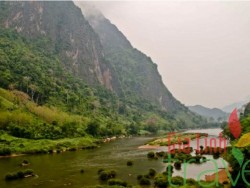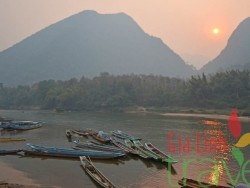Nong Khiaw
Luang Namtha
Nam Ou River Muong Khoi Luang Namtha province is located in the northwest of Laos, bordered by Myanmar in the northwest, China to the north, Oudomsay province to the southeast, and Bokeo province to the southwest. 39 ethnic groups make up the population of 125000, each groups having its own dialect, culture and lifestyle, but coexisting peacefully — a reflection of traditional solidarity. This province has a picturesque beauty with mountains, and many old temples. Although many temples have been destroyed during the war, there is still remaining one major attraction: an old temple noticeably different from other classic temples. The road twists and turns alongside the Nam Luan river, through beautiful vistas of wild countryside. A clearing in the vegetation presents a view of a characteristic village on the slope opposite, belonging to Thai Luan ethnic group. Covering nearly 30% of the province’s land area is the Nam Ha National Protected Area well known for a range of ecotourism activities. Due to its mountainous terrain the weather here can get quite cool, with temperatures generally not topping 30o C in the hot season (March-April) and dropping to as low as 0o C (December-January). During May-October, the southwestern monsoon brings the annual rains and marks the beginning of the new agricultural cycle. The village of Muang Sing is centered around a large market, where a lively weekly market takes place every Sunday. Being near the Chinese border, this market is an important goods-exchange point for border inhabitants of both sides, and hill people frequent it regularly. Attractions list: 1. The Nam Ha National Protected Area The mountainous center of Luang Namtha Province has been designated as the Nam Ha National Protected Area (NPA). It was first established by a Prime Minister’s Decree and stretches from the Chinese border through the middle of the province, covering over 222,400 hectares. The Nam Ha NPA’s landscape is very diverse, characterized by and ever changing mosaic of swidden fields and regenerating forests. Very old forest remains in a few remote areas due to inaccessibility and local custom. Within the NPA boundaries there are two peaks that exceed 2,000 meters, as well as an abundance of rivers and streams. The NPA’s main purpose is to protect biodiversity and habitat for wildlife found in northern Laos. Species such as Tiger, Leopard and the enormous Gaur (a type of wild cow) still roam the forest throughout the reserve, although large mammals are very hard to see because of low population densities and fear of people. Residents that are easier to encounter are the some 300 species of birds, which include Silver Pheasants, jewel-like Blue and Eared pittas as well as a diversity of bulbuls. On the highest peaks there are species more closely associated with the Himalayas and are found in only a few other parts of Laos. 2. Trekking in the Nam Ha NBCA Covering an area of 222.400 square-hectares and sharing an international border with the Xing young Protected Area in China, the Nam Ha National Biodiversity Conservation Area is one of the country’s largest protected areas and provides refuge for a wide range of wildlife species including tigers, sun bear, black-checked gibbon, and silver pheasant. Treks to the Nam Ha NBCA support natural resource conservation and traditional livelihoods. 3. River Journeys A fantastic way to travel through the Nam Ha NBCA is by raft or long-tail boat down the Nam Ha River, where it is common to see many bird and reptile species in the surrounding forest. A longer journey on the larger Namtha, a traditional trading route and tributary of the Mekong , links Luang Namtha to both Houei Xai and Luang Prabang. Boat trips up and down the entire Namtha require an overnight stay in the traditional boatmen’s village of Ban Khone Kham (Nale District). 4. Ancient City & Caves Explore the remains of the ancient city and temple, Khou Vieng and Vat Mahapot, and discover the little-known history of a civilization that formerly inhabited Vieng Phoukha District as early as the 15th century. Another must see in Vieng Phoukha is the labyrinth of caves fill with bats at Phou Prasat and the impressive tunnel-like formation of the Kao Rao cave near Nam Eng village. 5. Ethnic Group & Handicrafts With over twenty ethnic groups, Luang Namtha is one of Laos most ethically diverse and colorful provinces. Visit Muang Sing to see a wide variety of crafts produced by Akha, Yao, Tai Dam and Hmong villagers. In Namtha District. Bicycle nearby Tai Dam and Lanten villages to see the production of silk, paper and other local crafts. For a rich cultural experience, trek to remote villages with a local guide. Tours can be arranged in Luang Namtha, Muong Sing and Vieng Phoukha. 6. Historic Heritage of Muang Sing As a central point of trade and political administration that has changed hands over centuries, Muang Sing has many remaining historical sites including: That Xieng Teung stupa believed to contain a sacred relic of the Lord Buddha; remains of the ancient city walls and moat; residence of the former Muong Sing Prince, Panya Sekong; colonial French garrison; traditional Tai Lue houses; and the hospital of Dr. Tom Dooley, and American doctor who was stationed here in the 1960’s. 7. Sacred Forests Just at the edge of Luang Namtha Town the Tai Dam community has preserved a series of forest patches as sacred sites and cemeteries. These areas hold some of the Namtha Valley’s oldest and most impressive trees. Visiting these sites is permissible although always remember that you are visiting a highly venerated area that should be treated with the utmost respect. As you explore the area, older Tai Dam graves can be seen as large piles of soil while newer graves are marked by colorful flags, ritual items and symbols made from bamboo. Effigies of common household items are placed here for the use by the spirit in the afterworld. 8. Luang Namtha Museum The provincial museum has a variety of artifacts made by Luang Namtha’s multi-ethnic people. Of particular interest is the extensive collection of indigenous clothing as well as many agricultural tools and household implements used in daily life. the museum has an excellent collection of Buddha images, bronze drums, ceramics and textiles. Also of interest are the traditional hand-made weapons on display that were once used for hunting and national defense. 9. Muang Sing Exhibition Situated close to the center of town, the Muang Sing Exhibition is a good place to start exploring Muang Sing’s rich culture and history. The building was once the residence of Phanya Sekong a local lord who ruled over the area in the early 20th century. There is an excellent collection of traditional tools from the major ethnic groups in the area. Displayed on the building’s upper floor is an interesting variety of valuable 18th-19th century historic and religious pieces that have been preserved by the people of Muang Sing. 10. Buddhist Temples Tai Lue, the ethnic group most common to the Muang Sing Valley are devoutly Buddhist. Hence, there are 24 vats (temples) and monasteries in the area. Near the center of town there are a few important vats well worth a visit. Vat Luang, the most important in the area, is located off the main road next to the museum. Vat Xiang In and Vat Xiang Lae are a short walk from Vat Luang. Vat Namkeo Luang, which has a large monks quarters, is also quite beautiful and is located on the road to Xieng Kok near the junction with the paved road to Namtha. Also on the road to Xieng Kok is the magnificent Jorm Sing Stupa. 11. Old Namtha Town The old town, called Muang Namtha, is located near the airport around 6 km south of the new town. This area has many shaded pathways and older wooden houses built in the Tai Yuan style. In the old town you can see evidence of the second Indochina War-two old artillery pieces stand like sentinels at the entrance to the airport. 12. Buddhist Monument & Vats There are two beautiful Buddhist temples or vats located in the older part of Luang Namtha town That Phoum Pouk is located near Nam Ngaen village on a hill in the northeast part of the Namtha Valley. The original stupa ws constructed in 1628 to demarcate neutral terriory between the kingdoms of Lane Xang (centered in Luang Prabang) and Lanna (centered in Chiang Mai). In 1966 the old stupa was destroyed when an American plane dropped a bomb on it. The new monument seen besides the older, ruined stupa was constructed in 2003. 13. French Garrison and other Historic Buildings Muang Sing is a town with a rich history. Once closely associated with the Sipsongpanna Kingdom centered in present day Yunnan China, the town has been influenced by Chinese, Burmese and French occupants. Originally constructed in the 18th century following a deliberate urban plan, you can see the old city walls and moat about 7 blocks norht of the museum, and also an old rampart in the northwest part of the Sing Valley. Across from the market, around the corner from the District Administration Offices you can find the old French Garrison. The garrison is now used by the Lao army and is off-limits to visitors. Photographing this army base is prohibited. Across the street from the garrison is the former district hospital built in 1919. 14. Namkeo Waterfall The multi-tiered Namkeo waterfall is located about 2 kilometers from the That Xing Stupa and can be visited as part of a guided tour from the Muang Sing Guide office or while on the Akha Experience. 15. That Xieng Tung That Xieng Tung is the most important religious monument in Muang Sing. It is believed locally that the stupa contains the Adam’s-apple of the Lord Buddha. When the stupa was first constructed is still a mystery. To the left of the stupa is a stone stairway that leads to a sacred fountain and a sacred stone. If you follow the path to the right of the stupa heading downhill you might be able to find the old moat and wall that used to surround the site. The biggest festival of the year, Boun That Xieng Tung, is held here every year during the full moon of the 12th lunar month (usually November) and attracts a large crowd of people from around the province as well as Tai Lue Buddhists from as far top of a hill 5.5 km from the center of town on the road to Luang Namtha.


near the airport. Vat Bang Vieng Tai in Vieng Tai village just north of the airport and Vat Bang Luang Khone south of the airport were built by the valley’s Tai Yuan population (locally known as Tai Kalorm) and are well worth a visit.
